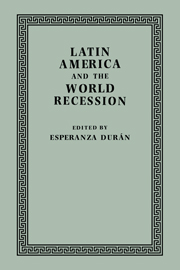Book contents
- Frontmatter
- Contents
- Contributors
- Preface
- 1 The Political Setting: ‘Business as Usual’ or a New Departure?
- Part One The Global Perspective
- 2 Latin America's Financial Crisis: Causes and Cures
- 3 A Comparison of Macroeconomic Strategies in South America
- 4 Latin American and East Asian NICs: Development Strategies Compared
- Part Two Case Studies
- Index
2 - Latin America's Financial Crisis: Causes and Cures
Published online by Cambridge University Press: 05 February 2012
- Frontmatter
- Contents
- Contributors
- Preface
- 1 The Political Setting: ‘Business as Usual’ or a New Departure?
- Part One The Global Perspective
- 2 Latin America's Financial Crisis: Causes and Cures
- 3 A Comparison of Macroeconomic Strategies in South America
- 4 Latin American and East Asian NICs: Development Strategies Compared
- Part Two Case Studies
- Index
Summary
When Mexico told its creditors in August 1982 that it could not pay its debts, neither banks nor borrowers nor governments were prepared for the financial crisis that quickly engulfed the rest of Latin America. How did the crisis reach such a pitch with apparently so little warning? Why did borrowers and lenders act as they did, and what were their shares of responsibility? Is the crisis simply a short-term liquidity problem, or does it have deeper roots in the development model of the major Latin American countries? Does the crisis threaten the solvency of individual banks – or even of the banking system as a whole? And will the ad hoc measures so far employed to tackle the debt crisis suffice? These are the issues that we try to explore below.
Developments in the 1970s
To understand the present situation we must go back to the beginning of the 1970s. Up to that time international banks were little involved in the business of development finance. They had concentrated their activities in Latin America (as in other parts of the developing world) on three areas: financing international trade through short-term loans; financing investment or working capital of multinational companies established in the countries; and domestic banking activity in those countries where a limited number of international banks had established branches. In exceptional cases some countries received bank loans for balance-of-payments support (often guaranteed by gold) or for projects guaranteed by third parties or by pledging of export contracts.
- Type
- Chapter
- Information
- Latin America and the World Recession , pp. 17 - 37Publisher: Cambridge University PressPrint publication year: 1985
- 2
- Cited by

